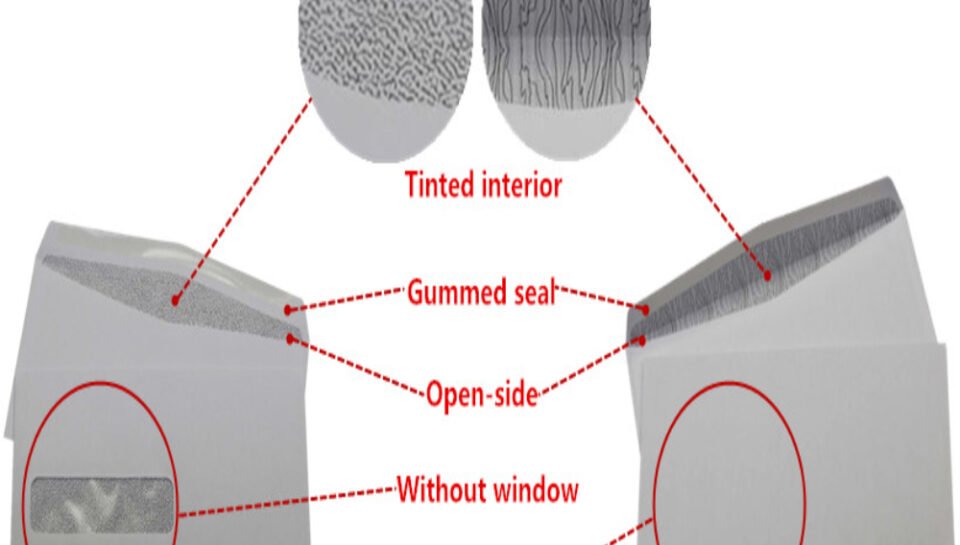
Describe the integration of security features in envelope design.
INTRODUCTION
In an era where information is currency, the importance of secure correspondence cannot be overstated. Whether used for financial documents, legal contracts, medical records, or sensitive corporate communication, envelopes must go beyond aesthetics—they must safeguard contents against tampering, unauthorized access, and identity theft. The integration of security features into envelope design provides a vital layer of protection while also enhancing the sender’s credibility and the recipient’s trust. This article explores the various ways security features are incorporated into envelope design and why they are essential in modern communication.
1. OPAQUE INTERIOR PRINTING
Security tinting or patterned interior printing prevents the envelope’s contents from being read through the paper. These intricate patterns obscure text visibility, especially under light, making them ideal for financial, legal, or personal information mailings.
2. TAMPER-EVIDENT SEALS
Envelopes equipped with tamper-evident adhesive strips or glue react visibly if someone attempts to open them. Once broken or resealed, the seal cannot be restored to its original condition, signaling possible interference and maintaining document integrity.
3. WATER-ACTIVATED OR PRESS-TO-SEAL CLOSURES
Advanced sealing technologies such as peel-and-seal or water-activated adhesives enhance security by eliminating the need for additional adhesives like tape or glue sticks. These strong seals deter unauthorized access during transit.
4. HOLOGRAPHIC SECURITY LABELS AND STAMPS
High-value or certified envelopes often include holographic stickers or stamps. These unique, hard-to-replicate features confirm authenticity and make it evident if the envelope has been compromised or counterfeited.
5. WINDOW PROTECTION FILMS
For window envelopes, security films ensure the window area doesn’t become a vulnerability. These protective films can be tear-resistant, UV-coated, or anti-static to prevent content exposure and maintain alignment.
6. MICROTEXT AND UV PRINTING
Microtext—tiny lines of text only readable under magnification—is often used around seal areas. When paired with UV-reactive inks, it becomes a covert verification feature visible only under specific light, adding an extra layer of fraud prevention.
7. VOID MESSAGES AND SECURITY INKS
Some envelopes include inks or labels that reveal hidden messages like “VOID” when tampered with. These chemically reactive inks alert recipients to possible breaches, deterring interference and unauthorized opening.
8. RFID-BLOCKING MATERIALS
For envelopes carrying smart cards or data-embedded documents, RFID-blocking layers prevent electronic skimming or data theft. These are increasingly common in government and financial mailings.
9. CUSTOM DIE-CUT SHAPES FOR AUTHENTICITY
Die-cut envelope flaps, notches, or seals with custom shapes can act as physical security features. Their unique design makes replication difficult and reveals tampering if misaligned upon resealing.
10. SERIAL NUMBERING AND TRACKING CODES
Envelopes can be printed with unique serial numbers or tracking codes for each piece. These identifiers facilitate audit trails, delivery verification, and authenticity checks—ideal for legal, financial, or confidential correspondence.
CONCLUSION
The integration of security features in envelope design transforms a simple mailing tool into a secure, tamper-proof communication vehicle. By implementing multiple layers of protection—visible and covert—organizations can ensure the privacy, authenticity, and integrity of their mailings. In sectors where confidentiality and trust are paramount, secure envelope design is not optional—it’s essential.
HASHTAGS
#SecureEnvelopeDesign #EnvelopeSecurity #TamperEvident #PrivacyMatters #ConfidentialMail #SecurityPrinting #AntiTampering #SecureCorrespondence #CorporateSecurity #DataProtection #FinancialMailing #MedicalConfidentiality #HolographicStamps #RFIDProtection #SecurityFeatures #CustomEnvelopeDesign #Microtext #SecureSeals #PostalSecurity #DocumentIntegrity #MailSafety #ConfidentialCommunication #SecureMailingSolutions #EnvelopeInnovation #TrustInDesign





